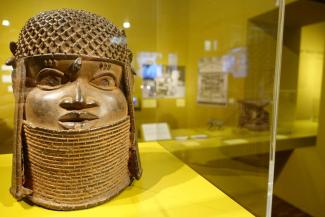Restitution
The return of the Benin objects

The exhibition displays 179 historical artworks made of bronze, ivory and wood, which come from the former city of Benin and belonged to the royal family. This year, they will be returned to Nigeria along with around 1,000 additional objects from other German museums (on the debate surrounding restitution see the contribution by Sabine Balk on www.dandc.eu).
As the exhibition documents in a timeline, the country of Nigeria and the Benin royal family, which still exists, have been calling for decades for the return of the looted works from museums in Europe and the US. “It is high time to right this wrong,” said the general director of the Nigerian National Commission for Museums and Monuments, Abba Isa Tijani, at the opening. He asked: “Why should we tolerate this serious mistake from the colonial era?”
He appreciates the exhibition by saying it was the beginning of the return of the Benin bronzes to Nigeria. According to Tijani, the Hamburg museum’s announcement of the restitution worked as a catalyst for negotiations with other museums. He felt that the significance of this development could not be overstated, and he is very much looking forward to future cooperation with German museums and new forms of collaboration.
The artefacts were created in various centuries at the court of Benin. The nobility paid craftspeople to represent important events in the history of the kingdom. In elaborate bronze sculptures and carvings from ivory and wood, they recorded royal successions or illustrated trade with Portuguese seafarers. Manillas, bracelets made of brass and copper that served as currency, are also documented on the bronze plaques, most of which stem from the 16th and 17th centuries. The director of the MARKK, Barbara Plankensteiner, considers the objects “outstanding artworks with world historical significance”.
A portion of the brass, as the exhibition demonstrates with reference to several objects, also came from Central European mills and was brought to West Africa by German trade companies in the 16th century via Hamburg and Antwerp. The Benin rulers traded the valuable metal for ivory and spices – as well as for people who had been enslaved during wars. The latter were transported to the slave market in the Portuguese city of Lagos and later to plantations in the Caribbean.
The Hamburg exhibition displays photographs that document the looting of the artwork from Benin at the end of the 19th century. In 1897, a troop of British soldiers attacked the city with machine guns. The British Empire had long been bent on gaining free access to the city and its trade – and on deposing the king. The military was aware of the existence of the treasures and planned to loot them in order to finance the invasion. Shortly thereafter, the artworks surfaced in London and Hamburg. In total, an estimated 3,000 to 5,000 objects were plundered.
Researching the trade networks
Another portion of the exhibition is devoted to the trade networks of the time. Gaiser, Umlauff, Konietzko and Brinkmann are the names of some the most important people and trading firms. They are connected by arrows to each other, but above all to the ethnographic museum, which is now the MARKK. This installation looks like the police bulletin boards that investigators set up in order to track down a network of recipients of stolen goods.
But the police never investigated this case. Captains, colonial authorities and business people enriched themselves through the sale of the stolen objects with impunity. Only now are museums and researchers beginning to investigate these trade networks. At the very least, experts want to digitise all of the plunder that was scattered around the world and publish it on the new online platform “Digital Benin”. This database will also serve as the basis for an exhibition at the planned Edo Museum of West African Art (EMOWAA) in Benin City.
Hamburg’s senator for culture, Carsten Brosda, believes this exhibition makes a “clear promise that all of the Benin objects in Hamburg will be restituted”. However, as a federal state, Hamburg alone cannot make a decision about restitution, since two countries are party to the negotiations. It can make preparations, though, for instance by adding the transfer of property to Hamburg’s city budget. The value of the artefacts has been appraised at € 60 million. The exhibition will run in Hamburg until the objects are returned either individually or collectively.
The MARKK is intensively engaged with questions of origin, authorship and the restitution of objects from the colonial period (also see my article in the Summer Special on www.dandc.eu).
Link
Digital Benin
https://digital-benin.org/
Anke Schwarzer is a freelance editor and teaches adult education courses on history and politics.
hallo@ankeschwarzer.com







